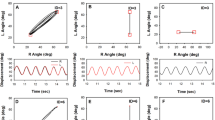Abstract.
Reaching to interact with an object requires a compromise between the speed of the limb movement and the required end-point accuracy. The time it takes one hand to move to a target in a simple aiming task can be predicted reliably from Fitts' law, which states that movement time is a function of a combined measure of amplitude and accuracy constraints (the index of difficulty, ID). It has been assumed previously that Fitts' law is violated in bimanual aiming movements to targets of unequal ID. We present data from two experiments to show that this assumption is incorrect: if the attention demands of a bimanual aiming task are constant then the movements are well described by a Fitts' law relationship. Movement time therefore depends not only on ID but on other task conditions, which is a basic feature of Fitts' law. In a third experiment we show that eye movements are an important determinant of the attention demands in a bimanual aiming task. The results from the third experiment extend the findings of the first two experiments and show that bimanual aiming often relies on the strategic co-ordination of separate actions into a seamless behaviour. A number of the task specific strategies employed by the adult human nervous system were elucidated in the third experiment. The general strategic pattern observed in the hand trajectories was reflected by the pattern of eye movements recorded during the experiment. The results from all three experiments demonstrate that eye movements must be considered as an important constraint in bimanual aiming tasks.









Similar content being viewed by others
References
Binsted G, Chua R, Helsen W, Elliottt D (2001) Eye-hand coordination in goal-directed aiming. Hum Mov Sci 20:563–585
Bizzi E, Kalil RE, Tagliasco V (1971) Eye-hand coordination in monkeys: evidence for centrally patterned organisation. Science 173:452–454
Carlton LG (1981) Visual information: the control of aiming movements. Q J Exp Psychol 33A:87–93
Carson RG (1989) Manual asymmetries: In defense of a multifactorial account. J Mot Behav 21:157–162
Cohen J (1969) Statistical power analysis for the behavioral sciences. Academic Press, New York
Corbetta D, Thelen E (1996) The developmental origins of bimanual coordination: A dynamic perspective. J Exp Psychol Hum Percept Perform 22:502–522
Corcos DM (1984) Two-handed movement control. Res Q Ex Sport 55:117–122
Elliott D (1992) Intermittent versus continuous control of manual aiming movements. In: Proteau L, Elliott D (eds) Vision and motor control. North-Holland, Amsterdam, pp 3–31
Elliott D, Lyons J, Chua R, Goodman D, Carson RG (1995) The influence of target perturbation on manual asymmetries in right-handers. Cortex 31:133–154
Fitts PM, Peterson JR (1964) Information capacity of discrete motor responses. J Exp Psychol 67:103–112
Fowler B, Duck T, Mosher M, Mathieson B (1991) The coordination of bimanual aiming movements: evidence for progressive desynchronization. Q J Exp Psychol A43:205–221
Helsen WF, Starkes JL, Elliott D, Buekers MJ (1998) Manual asymmetries and saccadic eye movements in right-handers during single and reciprocal aiming movements. Cortex 34:513–529
Helsen WF, Starkes JL, Elliott D, Ricker KL (2000) Coupling of eye, finger, elbow and shoulder movements during manual aiming. J Mot Behav 32:241–248
Hering E (1868/1977) The theory of binocular vision. Plenum Press, New York
Honda H (1982) Rightward superiority of eye movements in a bimanual aiming task. Q J Exp Psychol 34A:499–513
Kelso JAS, Schöner G (1988) Self-organisation of coordinative movement patterns. Hum Mov Sci 7:27–46
Kelso JAS, Southard DL, Goodman D (1979a) On the nature of human interlimb coordination. Science 203:1029–1031
Kelso JAS, Southard DL, Goodman D (1979b) On the coordination of two-handed movements. J Exp Psychol 5:229–238
Marteniuk RG, Mackenzie CL, Baba DM (1984) Bimanual movement control: information processing and interaction effects. Q J Exp Psychol A36:335–365
Peters M (1981) Attentional asymmetries during concurrent bimanual performance. Q J Exp Psychol A33:95–103
Robinson GH, Kavinsky RC (1976) On Fitts' law with two handed movements. IEEE Trans Syst Man Cybern 6:504–505
Roy EA, Elliott D (1989) Manual asymmetries in aimed movements. Q J Exp Psychol 41A:501–516
Schmidt RA (1988) Motor control and learning: a behavioural emphasis, 2nd edn. Human Kinetics, IL
Steenbergen B, Hulstijn W, de Vries A, Berger M (1996) Bimanual movement coordination in spastic hemiparesis. Exp Brain Res 110:91–98
Sugden D, Utley A (1995) Interlimb coupling in children with cerebral palsy. Dev Med Child Neurol 37:293–309
Teasdale N, Bard C, Fleury M, Young DE, Proteau L (1993) Determining movement onsets from temporal series. J Mot Behav 25:97–106
Acknowledgement.
Preparation of this manuscript was partly supported by a grant from the National Health and Medical Research Council, Australia, to the authors.
Author information
Authors and Affiliations
Corresponding author
Rights and permissions
About this article
Cite this article
Riek, S., Tresilian, J.R., Mon-Williams, M. et al. Bimanual aiming and overt attention: one law for two hands. Exp Brain Res 153, 59–75 (2003). https://doi.org/10.1007/s00221-003-1581-7
Received:
Accepted:
Published:
Issue Date:
DOI: https://doi.org/10.1007/s00221-003-1581-7




